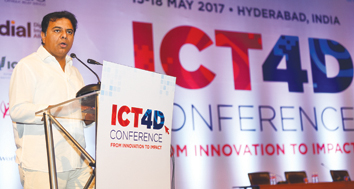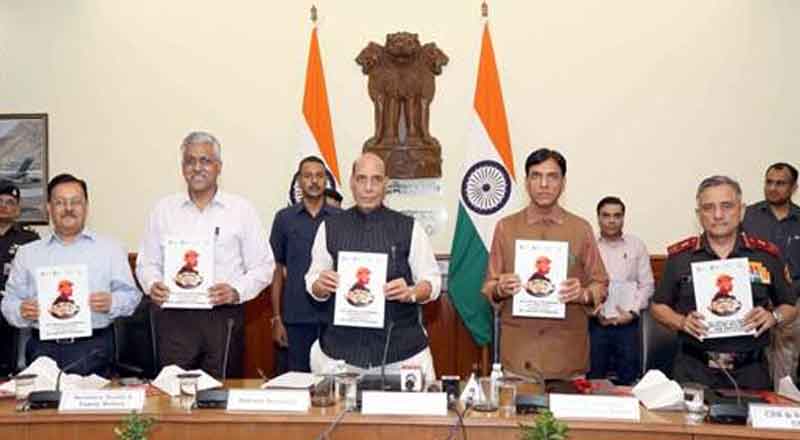The ICT4D Conference, was held in India for the first time, is a multi-disciplinary gathering of inspiring leaders, thought-provoking speakers, and engaged participants from around the world to explore how innovation in technology is increasing the impact of development work to make a measurable difference in millions of people’s lives and to achieve the UN Sustainable Development Goals (SDGs).
K.T. Rama Rao, Minister of Information Technology and Industries, Government of Telangana opened the ninth annual ICT4D Conference with a keynote speech where he reinforced his vision for Telangana to follow the path from innovation to impact, leading the charge to harness technology to empower citizens with access to information, advice, and opportunities.
“India is uniquely positioned to innovate to create solutions and opportunities for the world, and the state of Telangana is synonymous with innovation and incubators,” K.T. Rama Rao said to the approximately 1,000 delegates from across the Indian and international public sector, technology sector, and development and humanitarian organizations, gathered at the Hyderabad International Convention Centre.
Principal Secretary Jayesh Ranjan echoed these thoughts in his opening plenary discussion with Kate Wilson, CEO, Digital Impact Alliance (DIAL), where he discussed how Telangana is tieing its development to the SDGs, and accelerating progress by using technology for innovation.
Schuyler Thorup, Executive Vice-President for Overseas Operations, Catholic Relief Services (CRS) said, “India is at the forefront of digital innovation for the SDGs. India is also a global leader in the journey towards achieving the SDGs by forging partnerships between government and NGOs to empower frontline workers with digital tools in order to create lasting positive impact. It is very exciting for the ICT4D Conference to be here in India for the first time.”
On the opening plenary panel moderator Dr David Bergvinson, Director General, International Crops Research Institute for the Semi-Arid Tropics (ICRISAT) said that the fourth industrial revolution means that the boundaries between industries are being blurred by Big Data: “This innovation in the way we collect, analyse and act on data is what can help drive impact for sustainable and equitable development, and there are real life examples of how Big Data is helping society – in India and around the world.”
Data visualization tools are also critical in the analysis process. Chuck Conley, Nonprofit and Global Organizations Account Manager, Environmental Systems Research Institution (Esri) said, “While development work on-ground is critical, its efforts are sometimes hard to communicate: “ICT tools can help to visualize and communicate insights that are critical to the success of the development efforts.”
Rebecca Moore, Director, Google Earth, Earth Engine & Outreach, Google led an insightful session on using the power of the cloud to empower the development community to overcome challenges. Google’s Earth Engine platform gives the opportunity for anyone with a web browser, based anywhere to access fresh, relevant data at their fingertips. The huge data resources through the platform can help to derive actionable insights from local to global scale.
“Both private sector companies and NGOs need to adopt a multi-faceted approach when it comes to ‘Open’,” said Rhiannan Price, Senior Manager, Seeing a Better World Program, DigitalGlobe.
Syed Raza, Senior Director, Data, Digital Impact Alliance (DIAL) agreed that the approach to data sharing partnerships should be based on proven models and technical, commercial and government examples where the model has worked. Tangible incentives have a proven record of success in these ‘data for good’ models.
Aditya Agrawal, Director, Data Ecosystems Development, Global Partnership for Sustainable Development Data (GPSDD), reinforced the need to harness the data revolution for sustainable development. Data can improve decision-making and policy, citizen empowerment and encourage entrepreneurship and innovation – all driving factors towards meeting the SDGs.
“First and foremost, we want to use data to do good,” summarized Frank Schott, Vice President of Global Programs, NetHope, emphasizing the need to bring organizations together to share best practice and forge effective partnerships. “We need to bring the good work together to accelerate techniques that will help us to do more good with the data that we have. With this, we can improve development outcomes and save more lives.”
“There are many things in our world today that hinder development,” said Cherian Thomas, CEO, World Vision India on the opening panel session, “But technology can help overcome these challenges.”
“The principles of digital development give a good framework to address development challenges,” agreed Dr. Kyriacos Koupparis, Regional Science, Technology and Innovation Advisor, Asia, United States Agency for International Development (USAID). However, Dr. Partha Chakrabarti, Director and Professor, Computer Science and Engineering, IIT Kharagpur emphasized that while technology provides ways to solve problems, these must be appropriate innovations that use people’s own creativity to help themselves in their everyday activities: “Disruptive hi-tech innovations will only ever make people laborers, leaving them behind. We have to use people’s creativity to solve challenges.”
Prashant Shukla, National Technology Officer, Microsoft India detailed one such program – Digital Village Harisal – India’s first smart village. Microsoft and its private and NGO sector partners worked to create a digital village model that can be replicated at scale, to change the lives of an off-grid rural population.
While context-specific solutions are critical to success in the field, Neil Sahota, IBM Master Inventor, IBM Watson Group said that for those across sectors looking at developing those solutions, cognitive computing could offer the answer to the perennial question: “what if?”. “This requires a very different way of thinking, but cognitive computing will allow us to do things that we can’t even imagine now,” he said.
To achieve real impact from these programs, and to achieve the Sustainable Development Goals (SDGs), scalability is critical. Radha Basu, CEO, iMerit Technology Services highlighted the need for commercial investors to achieve scale.
Ultimately, said Lauren Woodman, CEO, NetHope, the development sector can learn from the digital sector how it can adapt in order to achieve the SDGs. “There is a $5-7 trillion shortfall to achieve the SDGs. This is a big gap, but tech can fill it, if we ask ourselves what we can do differently,” she said. Private sector technology companies have embraced the digital revolution wholeheartedly and they now have a strong focus on digital strategies. They are investing in data, they are asset-light, they are open to change and agile in the face of it. Development sector organisations need to move towards this model, argued Lauren: “It is a radically uncomfortable way to think about the way we do things. But, to achieve the SDGs, to help the people in need to reach those levels, we have to encourage different thinking.”
The conference was organized by a consortium of partners including Catholic Relief Services, Mercy Corps, World Vision, NetHope, the Anudip Foundation, Dalberg, the Digital Impact Alliance (DIAL), the Environmental Systems Research Institute (Esri), iMerit Technology Services, and the International Crops Research Institute for the Semi-Arid Tropics (ICRISAT). It was supported by Microsoft, Google Earth Outreach, CGIAR, Cyient, Digital Globe, DuPont, Oxfam, aWhere/GDA, and RTI International.
Pravin Prashant
pravin@spoindia.org





